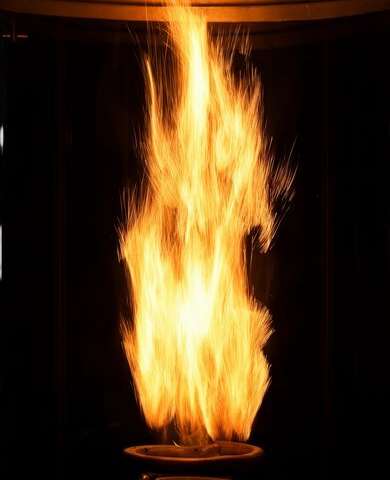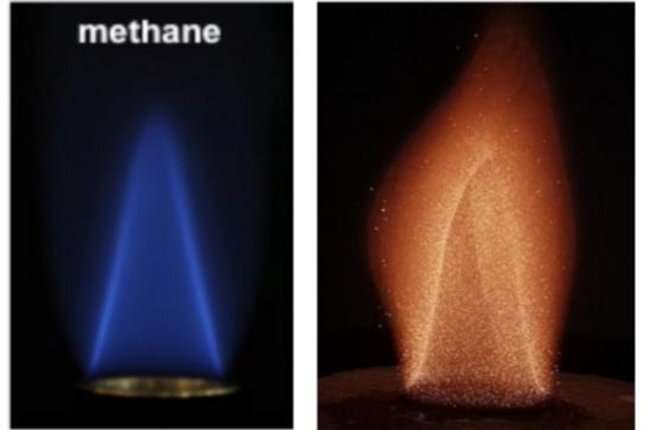Research set alight: Deciphering the combustion of metal fuels

The sun and wind are not anytime and anywhere available, so how do you temporarily store that energy? A group of researchers at Eindhoven University of Technology sees a dream candidate in metal fuels: CO2-free, reusable and with a high energy density. The first results are promising, but in order to deploy the technology on a large scale, it is first necessary to fully understand and control the combustion of these metal particles. Using an Advanced Grant of 2.5 million euros from the European Research Council (ERC), Professor of Combustion Technology Philip de Goey is now going to answer this 'burning' question.
Come on baby, light my fire. The Doors' megahit from the sixties wouldn't be out of place in Philip de Goey's lab. Efficient and clean fuel combustion is central to the research of this Professor of Combustion Technology. Research labs around the world use the methods developed by his group to fully understand and control the combustion of natural gas and other fossil fuels.
Recently, he has turned his attention to a new mystery: metal fuels. This is a promising, newly discovered energy carrier, even called 'the battery of the future' by some. However, there is a fundamental lack of understanding regarding the combustion of these metal fuels. This is unusual as this sort of combustion is not remotely new: it's been taking place for a long time in fireworks and rocket fuel, among other things.
How come we still know so little about the combustion of metal fuels?
"The combustion of metal fuels is indeed not a new phenomenon. For example, the metal you choose in fireworks determines which colors you see in the sky. There is only one important difference with metal fuels. In existing applications, the metal particles are surrounded by other materials which are flammable. This flammable environment also causes the metal particles to combust. In the case of metal fuels, the combustion has to come from the particles themselves and jump from one particle to another without the help of anything else. That makes it a completely new situation, one that has hardly before been looked at scientifically."
Why have metal fuels attracted so much attention recently?
"In recent years, the need for temporary energy storage has grown as we increasingly shift to renewable energy sources such as the sun and wind. Large-scale storage in batteries is too expensive and for hydrogen, which is also often mentioned, you need an enormous volume. Metals have a much higher energy density than hydrogen, so they are very compact and easy to transport as an energy carrier. I can imagine that you get the energy from the sun and wind at the spot where that works best, such as on the equator, and then transport it to other places."
advantage is that metal fuels are reusable, so you only have to make the powder once. The steps follow a circular process. No CO2 is produced during combustion and only rust remains. You then use hydrogen to convert it back into metal fuel. This process can be repeated over and over again. During combustion, energy is released in the form of heat. This can be used as steam in industrial processes or to power a turbine. This is particularly interesting in the short term for companies that need 1 to 10 MW of high-temperature heat. We're also looking at the maritime sector, where an enormous reduction in pollutant emissions is needed."
Why is it important that we understand the combustion precisely?
"In recent years, we've taken a number of nice steps in demonstrating that metal fuels really do have potential. For example, together with student team Team SOLID within the Metal Power consortium, we have realized a pilot installation that supplies 100 kW of energy. In the coming years, we will be scaling this up to a 1 MW installation several meters tall."
"However, if you want to scale up, you can't just build something. You need systems with stable combustion that also work as optimally as possible, something that appears to be very difficult. In fact, we know very little as of yet. How big should the particles be? How does the flame jump from one particle to another? How does a flame eventually arise and how fast does it move? And do the metal particles have to be globules or rods? Can they be porous? To what extent have they to be pure? Look at petrol and diesel engines, for example. They were invented at the end of the nineteenth century but they're still being improved. We have been driving around for years with engines that weren't that efficient and certainly weren't that clean."

How are you going to gain an understanding?
"We're going to do this in three steps, on three levels. First, by looking at how a single particle combusts. When a particle is heated up, it melts. It ignites and reacts with oxygen, creating a mixture of different combinations of the metal and oxygen. In the case of iron, this means different iron oxides such as Fe3O4 and Fe2O3. Furthermore, we have to finetune the situation in such a way that the particles don't vaporize, because then nanoparticle rust is released. You can't capture this and then you lose it. We are using models to try to simulate and therefore optimize this process."
"We are examining this both experimentally and numerically using a unique burner with which the metal particles are shot up and combusted like a fountain. We follow everything in detail with lasers and high-speed cameras."
"We then consider several loose particles together; this results in a so-called flame front. We're developing a new version of the so-called Heatflux method, which is now used in countless labs around the world to perform in-depth analysis of the flames of gaseous and liquid fuels. In the third step, we move from a one-dimensional flame front to a fully 3-D flame which is usually turbulent and therefore has a chaotic structure. This is why we speak of a multi-scale concept of the combustion of metal fuels. I will do all of this together with my combustion colleagues in the group, particularly Nico Dam, Jeroen van Oijen, Yuriy Shoshin, Rob Bastiaans and Giulia Finotello."
Nine Ph.D. students will work on the fundamental research into combustion: six funded by this ERC grant, two from a recently awarded NWO-TTW project and one with a CSC grant from China. Some Ph.D. students are also working on the reverse process—converting metal oxides back to metals (a process known in chemistry as 'reduction') – under Professor Niels Deen. Following this step, the circle will be complete and you'll be able to re-combust metal fuels.
In addition to this fundamental research at TU/e, work is being done on several fronts in order to apply, demonstrate and scale up metal fuels on a practical scale. The ultimate goal is to apply this technology in industry (in five years) or in a coal-fired power station (in ten years). De Goey is undertaking this within the framework of Metalot an innovation center affiliated with TU/e of which he is the initiator. Within this center, three large projects with a total value of seven million euros have been started in which a large number of research institutes and companies collaborate. The SOLID student team actively participates in all of these projects. These are:
- Lighthouse Metal POWER: a consortium funded by the Province of Noord-Brabant to build a 100-kW pilot installation for the combustion of iron powder at Swinkels Family Brewery. Participants are: TU/e, Metalot, SOLID, Uniper, Enpuls, Nyrstar, EM Group, Heat Power and Romico.
- Lighthouse Metal Energy Carrier: a consortium funded by the province to demonstrate a reduction system. Participants are: TU/e, Metalot, SOLID, Shell, EM Group, Heat Power, RISE (SE) and Pometon (IT).
- Metal POWER living Lab: OPZuid stimulation project (European Innovation program South of the Netherlands) to scale up the 100-KW system to 1 MW for the first pilot application of high-temperature heat and/or steam in industry. Participants are: Metalot, TU/e, SOLID, EM Group, Heat Power, Energy Storage NL, Nyrstar, Swinkels and Veolia.
Provided by Eindhoven University of Technology